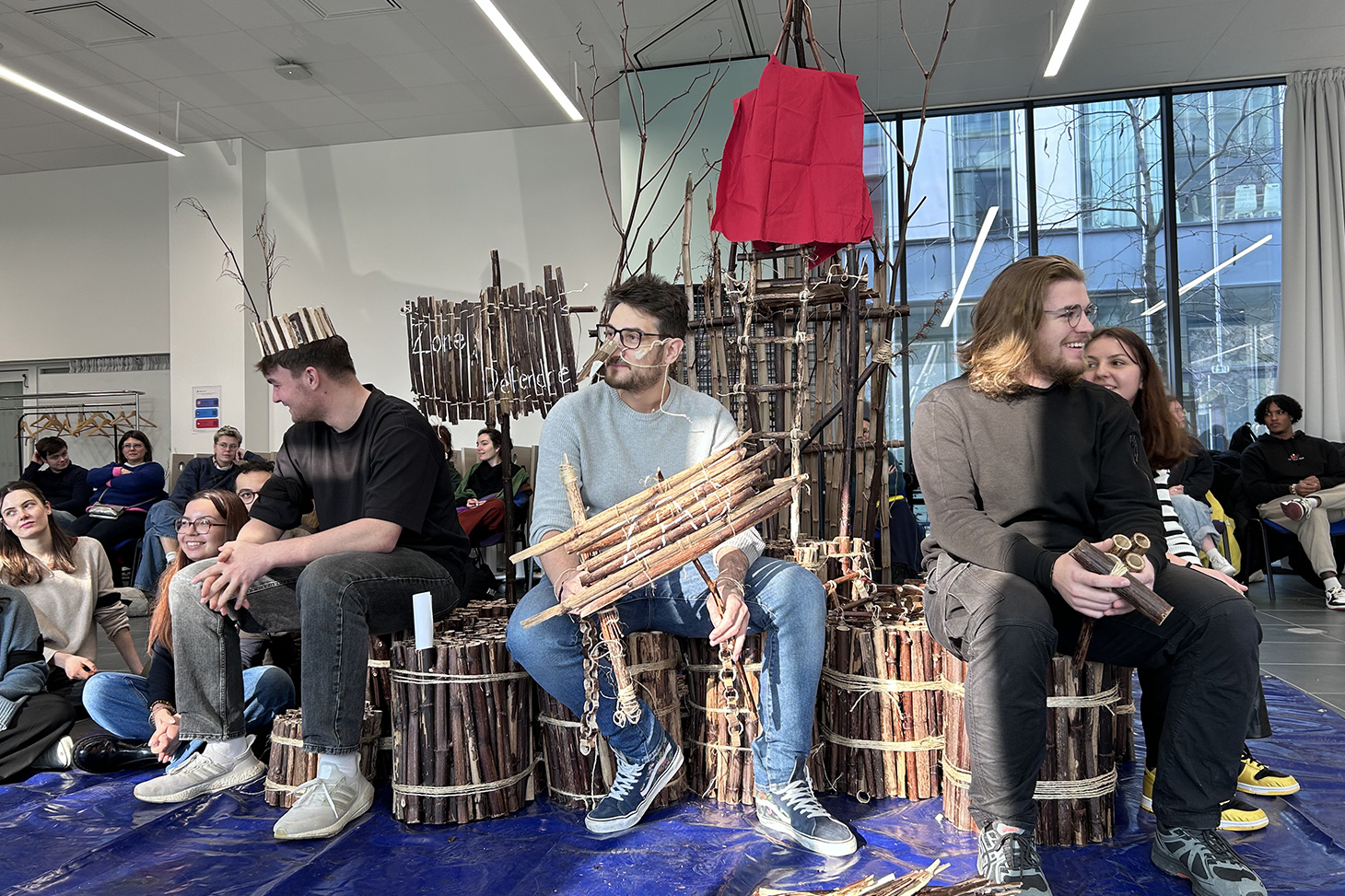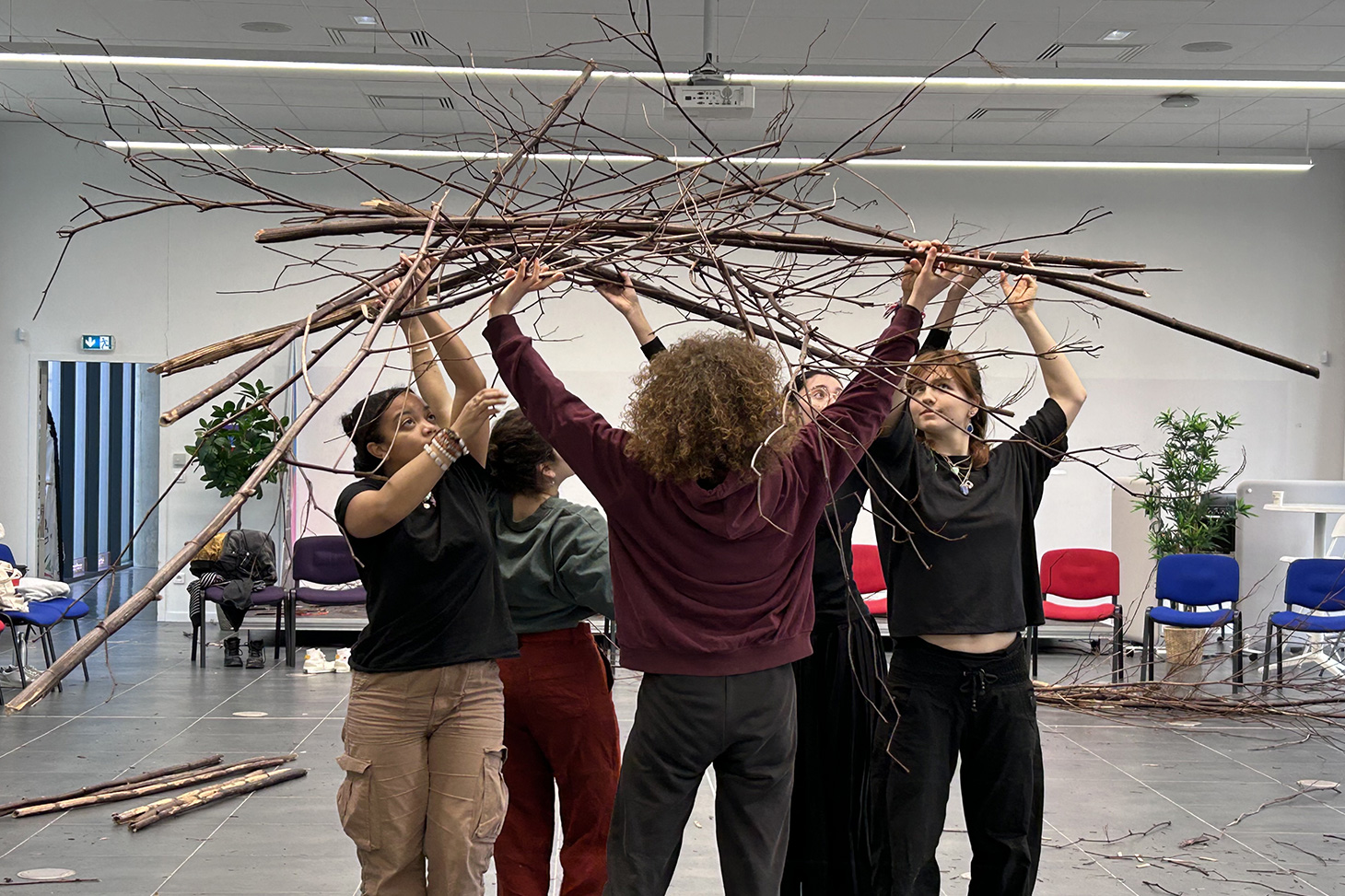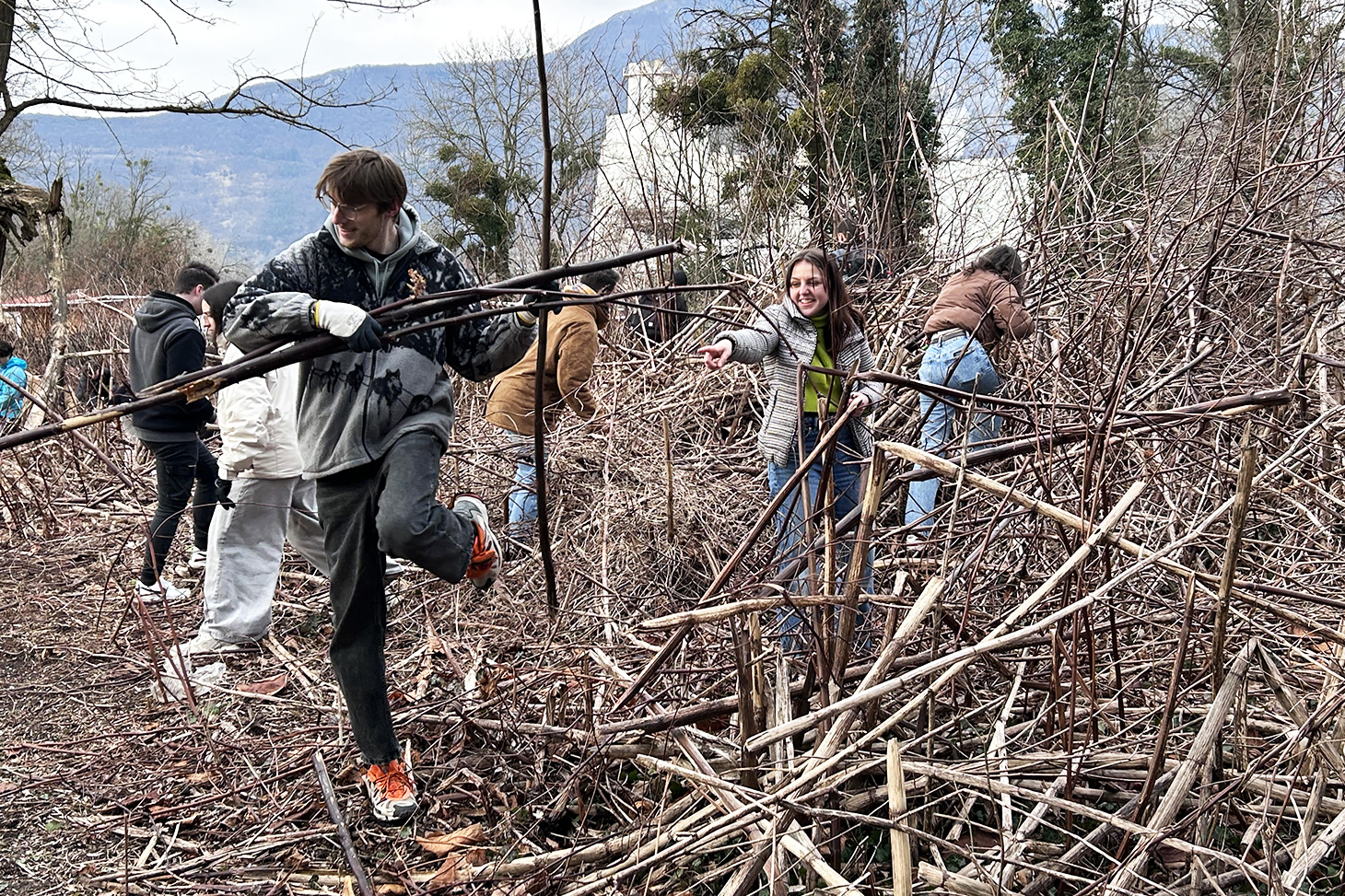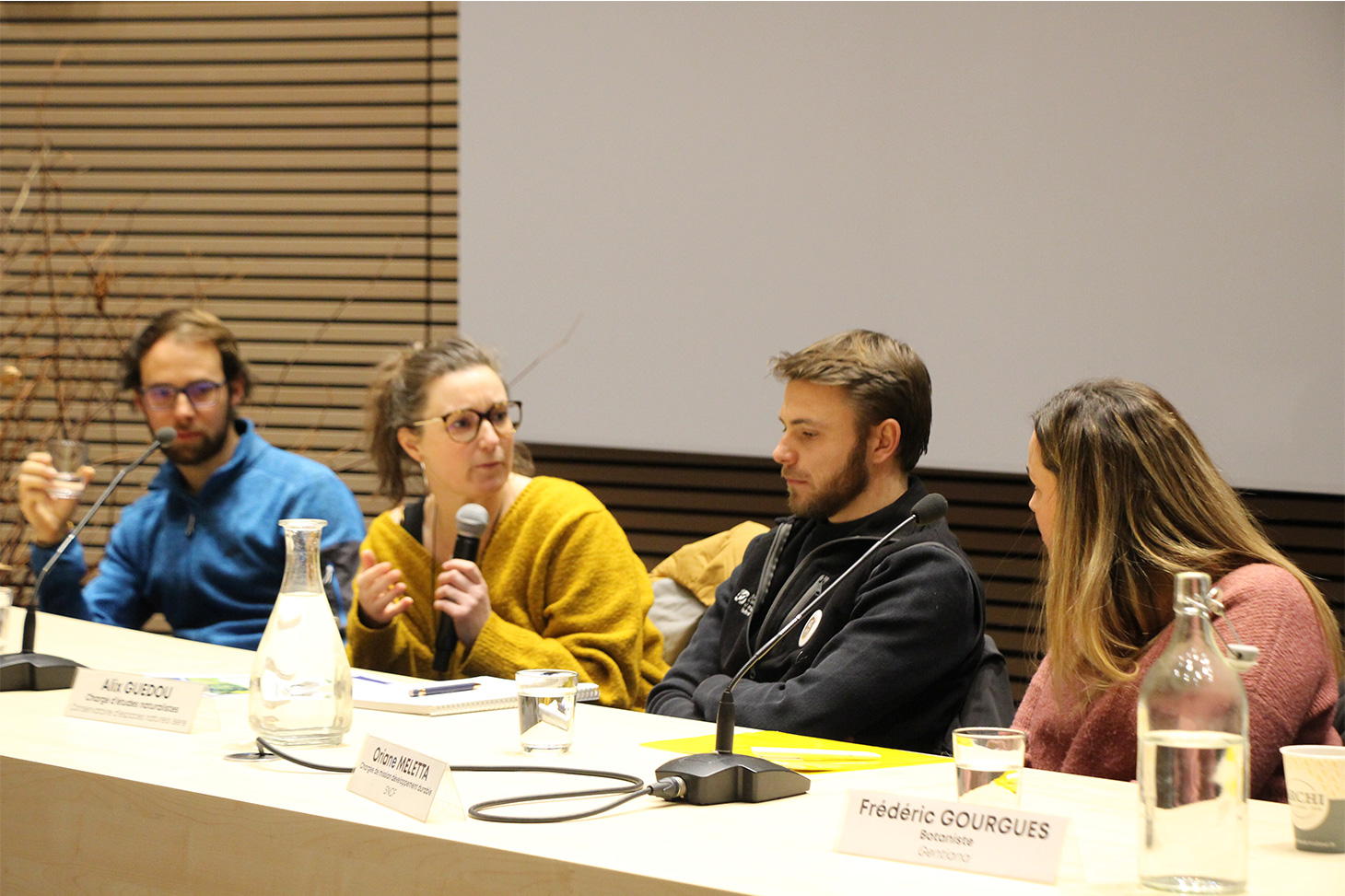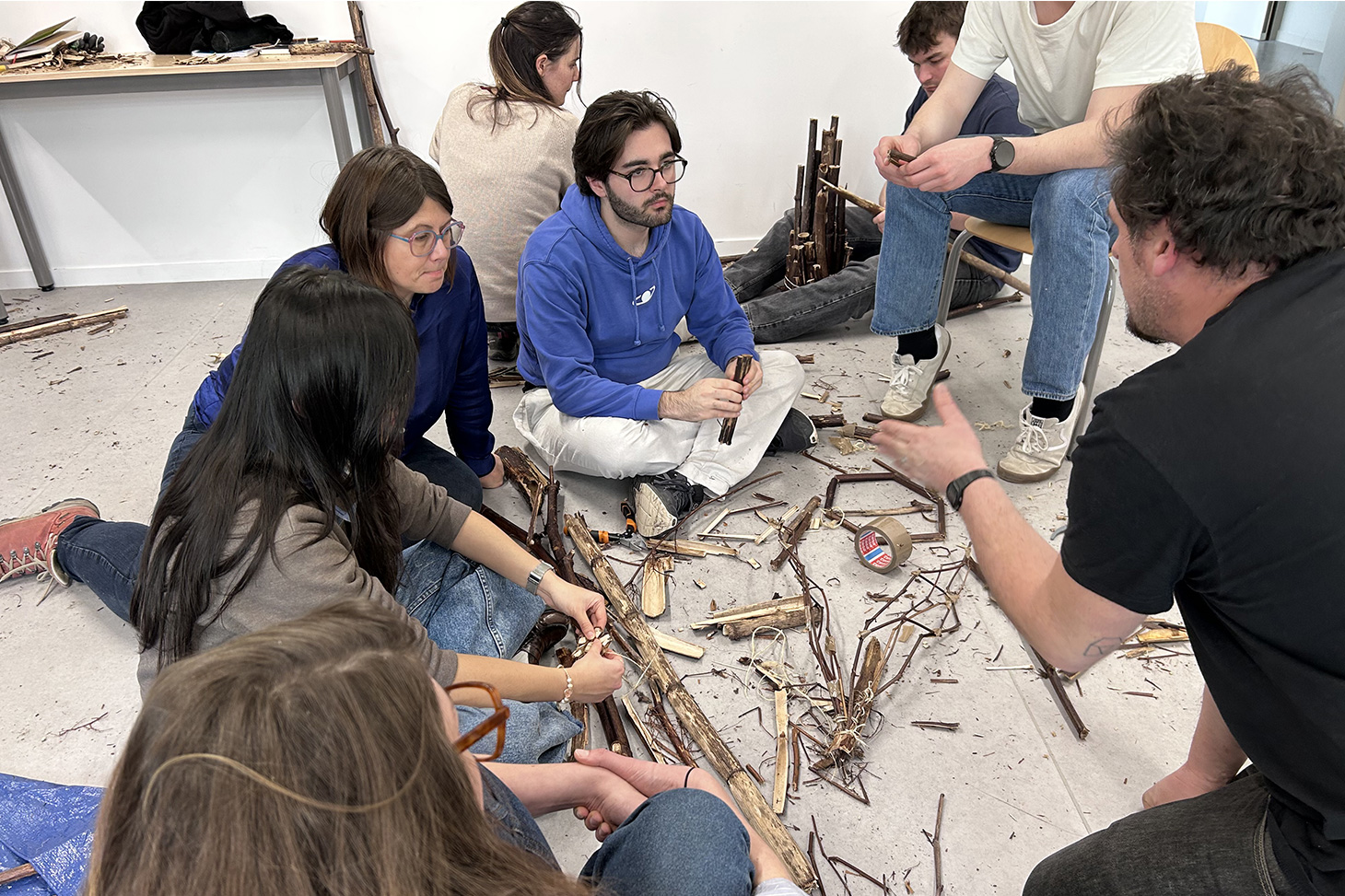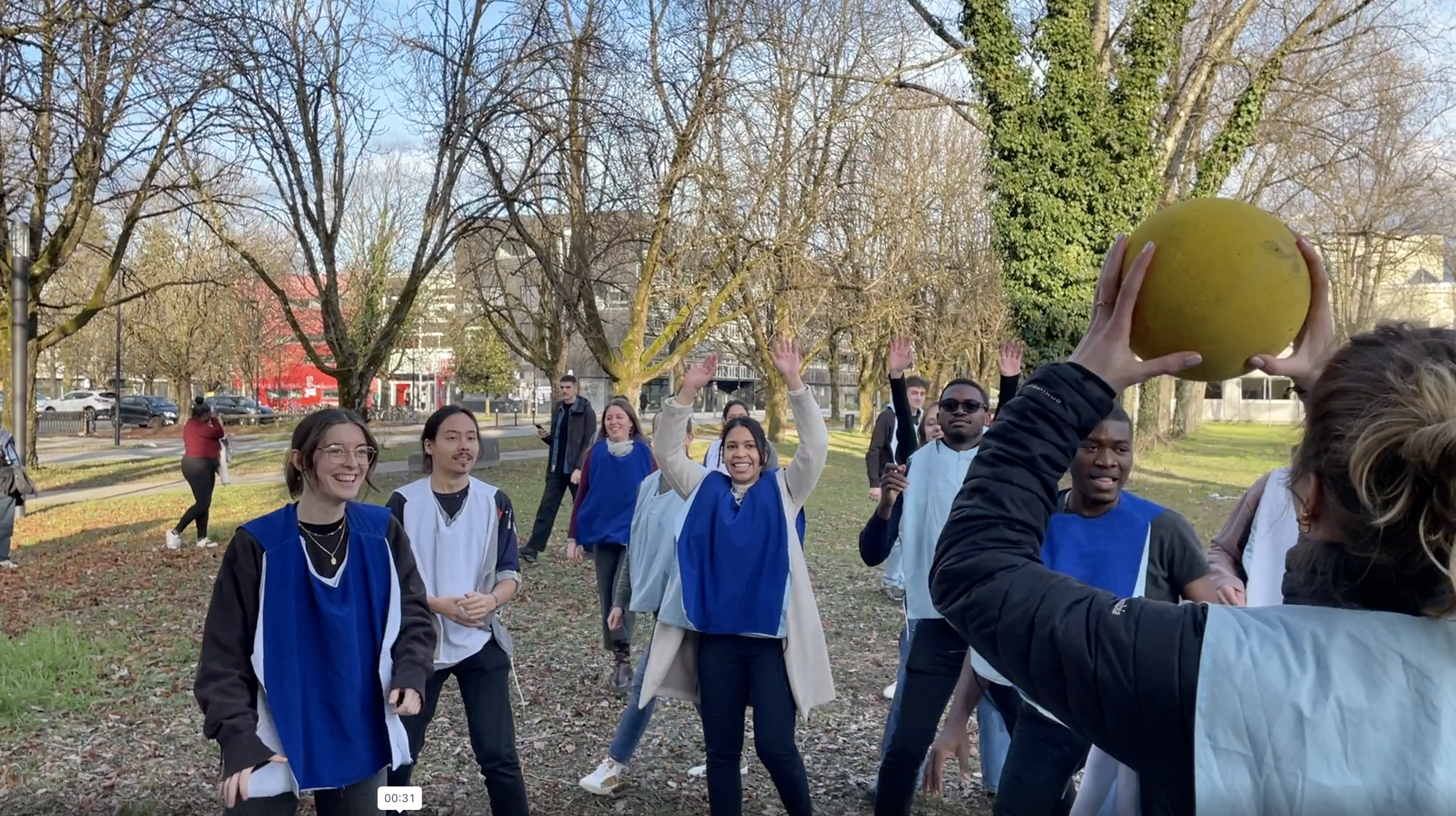Reconnecting with nature
Ephemeral University of Design
Ephemeral University of Design: an active pedagogy to tackle socio environemental issues
How can we rethink our relationship with nature to envision a desirable and respectful future for all living beings? Over three days, students from different disciplines explore a pressing socio-environmental issue. Through workshops and meetings with scientists, artists and users, they develop critical perspectives and inclusive, aesthetic and sustainable visions, paving the way for an engaged collective reflection.
France
Local
saint martin d'hères
It addresses urban-rural linkages
It refers to other types of transformations (soft investment)
Yes
2025-01-15
No
No
No
As a representative of an organisation
This three-days program invites about 100 masters students from six different disciplines to work together on a theme related to social and environmental transitions. Through workshops, meetings and conferences with practitioners and academics (integrated to the conception of the event), students explore the complexity of contemporary issues, develop critical perspectives and create innovative solutions using design methodologies.
Our key activities include :
• Analysing the complexity of the chosen problem and selecting an approach;
• Developing a critical perspective on the topics;
• Developing a proposal in a cross-disciplinary group;
• Making ideas tangible through inclusive, aesthetic and sustainable productions.
This initiative emphasises creativity, critical thinking and collaboration to address pressing challenges while promoting actionable and meaningful outcomes.
Our 6 participating programs :
• Master RESET : Resources, Environment and Society in Transition.
• Master GEOPOLITICS: Geography, Power, Space, Justice, Environment.
• Master in Design, Resilience and Habitats.
• Master in Design for Transitions
• DSAA in Product and Interactive Design.
• DNMADE Fashion design.
This program has been running since 2018, with its original format combining science, art and design to tackle complex and topical issues of social and environmental transition. Here we present the last two editions. The first edition of the Ephemeral University of Design focused on the ecological and social impact of the Olympic Games, which are scheduled to take place in the Auvergne Rhone Alpes region in 2030. The second focused on Japanese knotweed, a so-called invasive exotic plant that has taken root in our region.
Our key activities include :
• Analysing the complexity of the chosen problem and selecting an approach;
• Developing a critical perspective on the topics;
• Developing a proposal in a cross-disciplinary group;
• Making ideas tangible through inclusive, aesthetic and sustainable productions.
This initiative emphasises creativity, critical thinking and collaboration to address pressing challenges while promoting actionable and meaningful outcomes.
Our 6 participating programs :
• Master RESET : Resources, Environment and Society in Transition.
• Master GEOPOLITICS: Geography, Power, Space, Justice, Environment.
• Master in Design, Resilience and Habitats.
• Master in Design for Transitions
• DSAA in Product and Interactive Design.
• DNMADE Fashion design.
This program has been running since 2018, with its original format combining science, art and design to tackle complex and topical issues of social and environmental transition. Here we present the last two editions. The first edition of the Ephemeral University of Design focused on the ecological and social impact of the Olympic Games, which are scheduled to take place in the Auvergne Rhone Alpes region in 2030. The second focused on Japanese knotweed, a so-called invasive exotic plant that has taken root in our region.
Critical Design
wicked problems
materialization of ideas
Olympic Games
so-called invasive exotic plant
Within the Ephemeral university of Design, we use design as a tool for debate. A key skill in devising sustainable solutions is the ability to diagnose in systemic terms and to integrate multiple points of view. The intervention of artists and designers enables students to question their beliefs and emotions in relation to the subjects proposed to them, while taking scientific facts into consideration. This skill of putting transitional subjects into sensitive conversation is fundamental, but is not generally addressed in higher education.
For the first edition on the Olympic Games, the students imagined key moments of the closing ceremony. Through a series of sketches, they proposed to rethink the organisation of the competition, taking into account the environmental dimension at every moment. For example, one idea suggested awarding medals to the sports teams with the lowest environmental impact. Another one was to offer a cross-country skiing event on dirt and melted snow in the absence of snow in order to not use of snow guns.
For the second edition on Japanese knotweed, the issue was the management of this so-called invasive species, taking a nuanced view and showing that its impact can be both negative and positive, as with any species, even endemic ones. Jean-Sebastien Poncet, designer, make participants experimented with building a 1:1 scale raft from knotweed they had collected, and on this raft they explored the controversies surrounding invasive species. The characters on the raft included a bee, ants, chickens, a shepherdess and her sheep, a lawyer, a planner and an environmental activist.
In the course of our activities we want to address the hegemonic narratives that structure our societies, tackling the concepts of nature and culture and their separation, under the aegis of anthropologist Philippe Descolas' theory of the 4 ontologies. Are we really outside nature? Or are we nature? Do we defend nature or are we nature defending itself?
For the first edition on the Olympic Games, the students imagined key moments of the closing ceremony. Through a series of sketches, they proposed to rethink the organisation of the competition, taking into account the environmental dimension at every moment. For example, one idea suggested awarding medals to the sports teams with the lowest environmental impact. Another one was to offer a cross-country skiing event on dirt and melted snow in the absence of snow in order to not use of snow guns.
For the second edition on Japanese knotweed, the issue was the management of this so-called invasive species, taking a nuanced view and showing that its impact can be both negative and positive, as with any species, even endemic ones. Jean-Sebastien Poncet, designer, make participants experimented with building a 1:1 scale raft from knotweed they had collected, and on this raft they explored the controversies surrounding invasive species. The characters on the raft included a bee, ants, chickens, a shepherdess and her sheep, a lawyer, a planner and an environmental activist.
In the course of our activities we want to address the hegemonic narratives that structure our societies, tackling the concepts of nature and culture and their separation, under the aegis of anthropologist Philippe Descolas' theory of the 4 ontologies. Are we really outside nature? Or are we nature? Do we defend nature or are we nature defending itself?
The work on aesthetics is essential in the realization of this event. Aesthetics has to do with sensibility, i.e. the ability of the sensitive human being, the capacity of the sensitive human being, It allows students to immerse themselves in the theme and to understand that the visual environment in which they evolve plays a crucial role in fully grasping the issue ; it is important to understand the sphere of human interaction and its social context.
For the 2024 edition of the Ephemeral University of Design, the amphitheater was transformed into a stadium, and various objects were designed to bring this metamorphosis to life: entrance tickets, olympic games journal, a video montage featuring strong, provocative images from the Olympic Games, among others. Designer Gabriel Fontana also created the sportswear worn by the students, transformable outfits that question notions of inclusivity.
For the second edition, the students explored the work of circus artist Fanny Soriano. They mobilized body movement, object manipulation and physical theater to resonate with Japanese knotweed. In that case they questionned the Symbiocene, a concept coined by Australian environmental philosopher Glenn Albrecht. This term refers to a relational approach between humans and their environment, drawing inspiration from existing natural symbioses or imagining new ones.
The aim of our worshop activities are to seek a form of harmonious cohabitation, rather than a relationship of domination or colonization of the environment and its constituent elements.
For the 2024 edition of the Ephemeral University of Design, the amphitheater was transformed into a stadium, and various objects were designed to bring this metamorphosis to life: entrance tickets, olympic games journal, a video montage featuring strong, provocative images from the Olympic Games, among others. Designer Gabriel Fontana also created the sportswear worn by the students, transformable outfits that question notions of inclusivity.
For the second edition, the students explored the work of circus artist Fanny Soriano. They mobilized body movement, object manipulation and physical theater to resonate with Japanese knotweed. In that case they questionned the Symbiocene, a concept coined by Australian environmental philosopher Glenn Albrecht. This term refers to a relational approach between humans and their environment, drawing inspiration from existing natural symbioses or imagining new ones.
The aim of our worshop activities are to seek a form of harmonious cohabitation, rather than a relationship of domination or colonization of the environment and its constituent elements.
The first Ephemeral University of Design was a way for us to question the framework of the Olympic Games, the dynamics of competition, and, by extension, the distribution of genders and the segregation of populations. : ultimately, students came up with their own questions such as : what is performance? Is it about "always more"? A challenge defined by masculinity? the only way to win medals ?
During the first edition, the project animated by Gabriel fontana combined art, sports, and popular education. Through a feminist approach, students experimented new team sports that deconstruct group dynamics and foster empathy. These games, brought to life through performances, addressed key contemporary societal issues, ranging from the creation of social bonds to questions of identity and inclusion thanks to sports.
The second Ephemeral University of Design was also used to experiment during the raft activity debate, the concept of gender as the students played reversed roles, embodying genders different from their own. Bringing animals into the debate we also questionned the Rights of Nature, or Rights of the Earth, principles designed to protect entities in the biosphere, by recognizing them as people or living beings with rights of their own, based on their intrinsic value.
The poetic dimension and the metaphor of the raft were powerful elements in helping to understand not only cognitively, but with the body in the space and emotion of the game, the planetary limits and the need to “negotiate” with all stakeholders. Once again, questions of inclusion are approached here through sensitive experience, not through argumentation. In the discussions that follow, the students testify that the experience of playing ball with an imposed handicap has profoundly changed their representations.
During the first edition, the project animated by Gabriel fontana combined art, sports, and popular education. Through a feminist approach, students experimented new team sports that deconstruct group dynamics and foster empathy. These games, brought to life through performances, addressed key contemporary societal issues, ranging from the creation of social bonds to questions of identity and inclusion thanks to sports.
The second Ephemeral University of Design was also used to experiment during the raft activity debate, the concept of gender as the students played reversed roles, embodying genders different from their own. Bringing animals into the debate we also questionned the Rights of Nature, or Rights of the Earth, principles designed to protect entities in the biosphere, by recognizing them as people or living beings with rights of their own, based on their intrinsic value.
The poetic dimension and the metaphor of the raft were powerful elements in helping to understand not only cognitively, but with the body in the space and emotion of the game, the planetary limits and the need to “negotiate” with all stakeholders. Once again, questions of inclusion are approached here through sensitive experience, not through argumentation. In the discussions that follow, the students testify that the experience of playing ball with an imposed handicap has profoundly changed their representations.
The students are citizens in their own right. The professionals with whom we design the workshop work on socio-ecological transition projects that engage citizens and influence their lifestyles.
This initiative fosters a virtuous circle: students trained in these innovative and participatory practices disseminate the acquired knowledge and skills in their professional and community environments. They become agents of change, equipped to mobilize tools and methods that directly involve citizens, users, or communities in decision-making and design processes.
In this way, the scheme contributes to enriching civil society by:
- Raising awareness among future professionals of social, ecological, and cultural issues.
- Encouraging a collaborative approach where citizens become active partners in projects.
- Developing sustainable solutions that address the real needs of communities.
By emphasizing values such as inclusion, aesthetics, and sustainability, this scheme inspires a new generation of professionals who are prepared to tackle contemporary challenges while fostering human interaction and citizen participation.
At the end of the workshop, the students produce a performance (like a “fake” Olympic closing ceremony) which is open to the public in the Maison de la Création et de l'Innovation at Grenoble Alpes University. Although the audience so far has been mainly made up of other students, researchers and teachers, the participants are experimenting with public speaking skills that will serve them well in the future. In the first edition, an improv comedy coach trained them to gain confidence in public speaking.
This initiative fosters a virtuous circle: students trained in these innovative and participatory practices disseminate the acquired knowledge and skills in their professional and community environments. They become agents of change, equipped to mobilize tools and methods that directly involve citizens, users, or communities in decision-making and design processes.
In this way, the scheme contributes to enriching civil society by:
- Raising awareness among future professionals of social, ecological, and cultural issues.
- Encouraging a collaborative approach where citizens become active partners in projects.
- Developing sustainable solutions that address the real needs of communities.
By emphasizing values such as inclusion, aesthetics, and sustainability, this scheme inspires a new generation of professionals who are prepared to tackle contemporary challenges while fostering human interaction and citizen participation.
At the end of the workshop, the students produce a performance (like a “fake” Olympic closing ceremony) which is open to the public in the Maison de la Création et de l'Innovation at Grenoble Alpes University. Although the audience so far has been mainly made up of other students, researchers and teachers, the participants are experimenting with public speaking skills that will serve them well in the future. In the first edition, an improv comedy coach trained them to gain confidence in public speaking.
To organize the Ephemeral University of Design, we collaborate with experts, local actors, designers, and artists, from conception to implementation.
First edition:
Camille Riom: Environmental designer. She led a workshop on mapping stakeholders in the Olympic Games.
Julien Loy: Head of the Sports Department at Grenoble Alpes Métropole. He provided expertise on managing infrastructures such as the Stade des Alpes and Pole Sud ice rink.
Fabienne Gillonnier: Researcher on gender discrimination in mountain sports. She shared her expertise with students.
Paul Nichilo: Actor with the Imp’Acte company. He added a theatrical and playful dimension to the event.
Maya Cloetens: Student and elite biathlete at UGA. She shared her experience of ecological challenges in her practice.
Gabriel Fontana: Designer. He led workshops on inclusive sports with students.
Second edition:
Fanny Dommanget: Researcher at INRAE, specializing in invasive species ecology. She provided expertise to students.
Florence Piola: Researcher in plant ecology, studying invasive species and their ecological impact. She shared her knowledge with students.
Lucille Dargent: Technician for Natural Spaces at Grenoble Alpes Métropole. She provided her expertise to students.
Loïc Orillard: Project manager for ecological renaturation at Grenoble Alpes Métropole. He shared his knowledge with students.
Frédéric Gourgues (Gentiana): Study and training officer at the Gentiana association. He shared his expertise with students.
Alix Guedou: Naturalist study officer and nature guide. he shared her expertise with students.
Oriane Meletta: Sustainable development project manager at SNCF. She provided her expertise to students.
Jean-Sébastien Poncet: Designer. He guided students in a workshop on Japanese knotweed.
Fanny Soriano: Circus artist. She led a workshop exploring the body’s relation to Japanese knotweed.
Hexagone Meylan: National theater, they assisted in funding and identifying contributors.
First edition:
Camille Riom: Environmental designer. She led a workshop on mapping stakeholders in the Olympic Games.
Julien Loy: Head of the Sports Department at Grenoble Alpes Métropole. He provided expertise on managing infrastructures such as the Stade des Alpes and Pole Sud ice rink.
Fabienne Gillonnier: Researcher on gender discrimination in mountain sports. She shared her expertise with students.
Paul Nichilo: Actor with the Imp’Acte company. He added a theatrical and playful dimension to the event.
Maya Cloetens: Student and elite biathlete at UGA. She shared her experience of ecological challenges in her practice.
Gabriel Fontana: Designer. He led workshops on inclusive sports with students.
Second edition:
Fanny Dommanget: Researcher at INRAE, specializing in invasive species ecology. She provided expertise to students.
Florence Piola: Researcher in plant ecology, studying invasive species and their ecological impact. She shared her knowledge with students.
Lucille Dargent: Technician for Natural Spaces at Grenoble Alpes Métropole. She provided her expertise to students.
Loïc Orillard: Project manager for ecological renaturation at Grenoble Alpes Métropole. He shared his knowledge with students.
Frédéric Gourgues (Gentiana): Study and training officer at the Gentiana association. He shared his expertise with students.
Alix Guedou: Naturalist study officer and nature guide. he shared her expertise with students.
Oriane Meletta: Sustainable development project manager at SNCF. She provided her expertise to students.
Jean-Sébastien Poncet: Designer. He guided students in a workshop on Japanese knotweed.
Fanny Soriano: Circus artist. She led a workshop exploring the body’s relation to Japanese knotweed.
Hexagone Meylan: National theater, they assisted in funding and identifying contributors.
Our approach is based on the interaction of different areas of knowledge, which intersect and enrich each other to create new insights.
The first expertise mobilized is that of designers, who conceive and coordinate the workshop using methods specific to their discipline. What makes design unique is its ability to connect diverse stakeholders and structure a methodological process. This approach enables the creation of various proposals, performances, objects, services, to address the issues at hand.
At the heart of the Ephemeral University of Design are socio-ecological challenges. Ecology, therefore, represents the second knowledge area, brought by researchers and field practitioners accustomed to applying systemic thinking. They ensure the scientific accuracy of the data upon which students base their proposals.
The third dimension involves ensuring that transition proposals are democratic and inclusive. This entails exploring stakeholders’ perceptions, values, and concerns regarding the social, environmental, and technological dynamics of the project. These differing viewpoints are presented to students, with debates organized among stakeholders throughout the workshop to foster collective reflection.
Art takes its rightful place in our pedagogy that engages 3 dimensions :
- The Head: Sharing knowledge and theories.
- The Body: Experimentation and physical engagement.
- The Heart: Expressing emotions and fostering a connection with oneself, others, and the living world.
The artistic and experiential dimension is essential to this pedagogy, as it complements rationality with an emotional approach, enabling both personal and collective transformation.
By bringing together these various forms of knowledge, our initiative aims to create innovative, inclusive, and sustainable solutions that address the complexity of contemporary challenges while immersing participants in a holistic intellectual, sensory, and emotional experience.
The first expertise mobilized is that of designers, who conceive and coordinate the workshop using methods specific to their discipline. What makes design unique is its ability to connect diverse stakeholders and structure a methodological process. This approach enables the creation of various proposals, performances, objects, services, to address the issues at hand.
At the heart of the Ephemeral University of Design are socio-ecological challenges. Ecology, therefore, represents the second knowledge area, brought by researchers and field practitioners accustomed to applying systemic thinking. They ensure the scientific accuracy of the data upon which students base their proposals.
The third dimension involves ensuring that transition proposals are democratic and inclusive. This entails exploring stakeholders’ perceptions, values, and concerns regarding the social, environmental, and technological dynamics of the project. These differing viewpoints are presented to students, with debates organized among stakeholders throughout the workshop to foster collective reflection.
Art takes its rightful place in our pedagogy that engages 3 dimensions :
- The Head: Sharing knowledge and theories.
- The Body: Experimentation and physical engagement.
- The Heart: Expressing emotions and fostering a connection with oneself, others, and the living world.
The artistic and experiential dimension is essential to this pedagogy, as it complements rationality with an emotional approach, enabling both personal and collective transformation.
By bringing together these various forms of knowledge, our initiative aims to create innovative, inclusive, and sustainable solutions that address the complexity of contemporary challenges while immersing participants in a holistic intellectual, sensory, and emotional experience.
Mainstream actions in the field of innovation are in the form of hakkathons. But hakkathons are solution-oriented, not problem-oriented. Several research studies have shown that the results of hakkathons are often disappointing and difficult to implement.
Here, we offer an in-depth experience of problematization rather than solution-finding. This is an essential skill for which our students are not sufficiently prepared. It relies on interdisciplinarity and the articulation of science, art and design.
Furthermore, in France, universities don't traditionally teach design, nor do they use design to teach; this is the domain of design schools, which operate outside universities. Our core mission is to mobilize design in traditional university curricula to work on socio-ecological transitions.
The students are actors in the worshop:
Students are provided with a framework within which they evolve with a high degree of autonomy and meet stakeholders to choose the angle through which they will address the issue.
The use of head body and heart pedagogy:
- The Head: Sharing knowledge and theories.
- The Body: Experimentation and physical engagement.
- The Heart: Expressing emotions and fostering a connection with oneself, others, and the living world.
Interdisciplinarity :
Opportunities for truly interdisciplinary work are rare at university. In their feedback, students testified that these encounters had been very enriching, showing them different ways of approaching problems.
Here, we offer an in-depth experience of problematization rather than solution-finding. This is an essential skill for which our students are not sufficiently prepared. It relies on interdisciplinarity and the articulation of science, art and design.
Furthermore, in France, universities don't traditionally teach design, nor do they use design to teach; this is the domain of design schools, which operate outside universities. Our core mission is to mobilize design in traditional university curricula to work on socio-ecological transitions.
The students are actors in the worshop:
Students are provided with a framework within which they evolve with a high degree of autonomy and meet stakeholders to choose the angle through which they will address the issue.
The use of head body and heart pedagogy:
- The Head: Sharing knowledge and theories.
- The Body: Experimentation and physical engagement.
- The Heart: Expressing emotions and fostering a connection with oneself, others, and the living world.
Interdisciplinarity :
Opportunities for truly interdisciplinary work are rare at university. In their feedback, students testified that these encounters had been very enriching, showing them different ways of approaching problems.
The methodology we use involves 4 steps :
Step 1: research and immersion in the subject through reading, videos and discussions with stakeholders, some of whom have been identified in advance.
Step 2: create the group that will design the system, including all the stakeholders finally identified
Step 3: Design of workshop schedule
- identification of roles of each participants
- Partnership with artists and designers to support the workshops
- Drawing on the research and current projects of all stakeholders
Step 4: Implementation of the program around various workshops involving students and stakeholders during 3 days
Step 5: Feedback and valorization
- Survey students and share results with training managers.
Step 1: research and immersion in the subject through reading, videos and discussions with stakeholders, some of whom have been identified in advance.
Step 2: create the group that will design the system, including all the stakeholders finally identified
Step 3: Design of workshop schedule
- identification of roles of each participants
- Partnership with artists and designers to support the workshops
- Drawing on the research and current projects of all stakeholders
Step 4: Implementation of the program around various workshops involving students and stakeholders during 3 days
Step 5: Feedback and valorization
- Survey students and share results with training managers.
This program is fully replicable and adaptable to any theme related to ecological transitions. Its structure is based on several key elements: the choice of a theme, the identification of a designer and an artist who incorporate this theme into their practice, the mobilisation of relevant stakeholders (researchers, local actors, users, etc.) and the selection of partner Masters programs.
For the last two years, we have tried to select themes related to current events in order to increase the relevance and impact of the event.
For the three-day planning, the organisers use a "sequencer", a kind of script that precisely describes each moment of the program and its duration. We also create sub-groups of students to mix disciplines and encourage interdisciplinary exchanges.
For the conferences, we use the innovative "Science Café" format, which differs from a traditional lecture in its interactive approach: over two hours, students freely ask their questions, making the discussion more dynamic, unpredictable and engaging. This format adapts to all topics, even the most complex ones.
Finally, the success of the program depends on finding a suitable venue that provides both a space for conferences and access to tools and materials for practical work. So far, these meetings have taken place on university premises, but they could easily be transferred to other contexts.
In the future, this format could be adapted in various ways. One possible variation we would like to try is a mix of citizens and students, to take part in the program.
For the last two years, we have tried to select themes related to current events in order to increase the relevance and impact of the event.
For the three-day planning, the organisers use a "sequencer", a kind of script that precisely describes each moment of the program and its duration. We also create sub-groups of students to mix disciplines and encourage interdisciplinary exchanges.
For the conferences, we use the innovative "Science Café" format, which differs from a traditional lecture in its interactive approach: over two hours, students freely ask their questions, making the discussion more dynamic, unpredictable and engaging. This format adapts to all topics, even the most complex ones.
Finally, the success of the program depends on finding a suitable venue that provides both a space for conferences and access to tools and materials for practical work. So far, these meetings have taken place on university premises, but they could easily be transferred to other contexts.
In the future, this format could be adapted in various ways. One possible variation we would like to try is a mix of citizens and students, to take part in the program.
The DONUT concept, developed by Kate Raworth, serves as a framework for all the workshop designed by the UGA Design Factory, integrating social and environmental issues to envision a fair and sustainable societal model. This model is based on two dimensions: the outer boundary, defined by the nine planetary boundaries established in 2009 by a team of researchers from the Stockholm Resilience Centre, and the inner floor, which addresses essential social needs.
The nine planetary boundaries refer to thresholds beyond which Earth's natural systems may be destabilized, threatening human living conditions. Among these boundaries, those related to climate change and biodiversity loss are particularly emphasized in the Ephemeral Universities of Design.
Regarding social justice, which constitutes the inner floor of the donut, the focus is on three key areas: education, gender equality, and social equity. The interface between these different dimensions aims to ensure that the fundamental needs of every individual are met in an equitable framework, while respecting the planet’s ecological limits.
In our region of the Alps, rising temperatures, which could reach +4°C by 2050 under a +2°C global warming scenario, are already disrupting the mountain economy, which is primarily organized around the winter sports industry. Additionally, biodiversity collapse, one of the five causes of which, according to IPBES, is the proliferation of invasive plants, is affecting mountain agriculture, which is already challenging due to the limited use of machinery.
In our work on the upcoming 2030 Winter Olympics in the Alps, and on the Japanese knotweed that has been spreading along our riverbanks and climbing in altitude, we are collaborating with students and stakeholders to rethink ways to coexist with and combat these challenges. We are working in a systemic way on proposals that combine both mitigation and adaptation strategies.
The nine planetary boundaries refer to thresholds beyond which Earth's natural systems may be destabilized, threatening human living conditions. Among these boundaries, those related to climate change and biodiversity loss are particularly emphasized in the Ephemeral Universities of Design.
Regarding social justice, which constitutes the inner floor of the donut, the focus is on three key areas: education, gender equality, and social equity. The interface between these different dimensions aims to ensure that the fundamental needs of every individual are met in an equitable framework, while respecting the planet’s ecological limits.
In our region of the Alps, rising temperatures, which could reach +4°C by 2050 under a +2°C global warming scenario, are already disrupting the mountain economy, which is primarily organized around the winter sports industry. Additionally, biodiversity collapse, one of the five causes of which, according to IPBES, is the proliferation of invasive plants, is affecting mountain agriculture, which is already challenging due to the limited use of machinery.
In our work on the upcoming 2030 Winter Olympics in the Alps, and on the Japanese knotweed that has been spreading along our riverbanks and climbing in altitude, we are collaborating with students and stakeholders to rethink ways to coexist with and combat these challenges. We are working in a systemic way on proposals that combine both mitigation and adaptation strategies.
The project successfully trained 170 students, integrating practical approaches and experimental activities to implement their ideas. This hands-on experience enabled them to engage deeply with projects and proof of concept (POC) initiatives, fostering their creativity and problem-solving skills. Additionally, the project provided a platform for debates and choreographic works, which allowed for rich discussions and the exploration of different perspectives.
One of the key outcomes was the positive shift in the students’ perceptions, during the 3 days workshop. Also, the project encouraged them to reflect on their careers and to make more informed decisions about their future work. This change in perspective was also visible among stakeholders who were directly involved, leading to broader engagement and support for similar initiatives.
The project’s impact extended beyond the immediate participants, inspiring both students and stakeholders. For example, Fanny, one of the coach, stated, "I must say that I am now greatly inspired by the theme of invasive plants and Japanese knotweed. I think it will deeply influence my personal research." This shows the project’s ability to spark new ideas and fuel personal development.
Indirect beneficiaries also benefited from the public access to the project’s results, which encouraged wider community engagement and the sharing of knowledge. Ultimately, the project’s diverse activities resulted in a transformative experience, equipping students with the tools to reconsider their perspectives and engage with new, relevant topics in innovative ways.
For more analytics results see pdf attached.
One of the key outcomes was the positive shift in the students’ perceptions, during the 3 days workshop. Also, the project encouraged them to reflect on their careers and to make more informed decisions about their future work. This change in perspective was also visible among stakeholders who were directly involved, leading to broader engagement and support for similar initiatives.
The project’s impact extended beyond the immediate participants, inspiring both students and stakeholders. For example, Fanny, one of the coach, stated, "I must say that I am now greatly inspired by the theme of invasive plants and Japanese knotweed. I think it will deeply influence my personal research." This shows the project’s ability to spark new ideas and fuel personal development.
Indirect beneficiaries also benefited from the public access to the project’s results, which encouraged wider community engagement and the sharing of knowledge. Ultimately, the project’s diverse activities resulted in a transformative experience, equipping students with the tools to reconsider their perspectives and engage with new, relevant topics in innovative ways.
For more analytics results see pdf attached.

